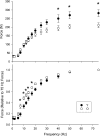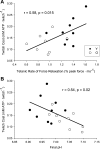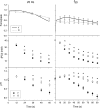Lower energy cost of skeletal muscle contractions in older humans
- PMID: 20032262
- PMCID: PMC2838655
- DOI: 10.1152/ajpregu.00713.2009
Lower energy cost of skeletal muscle contractions in older humans
Abstract
Recent studies suggest that the cost of muscle contraction may be reduced in old age, which could be an important mediator of age-related differences in muscle fatigue under some circumstances. We used phosphorus magnetic resonance spectroscopy and electrically elicited contractions to examine the energetic cost of ankle dorsiflexion in 9 young (Y; 26 +/- 3.8 yr; mean +/- SD) and 9 older healthy men (O; 72 +/- 4.6). We hypothesized that the energy cost of twitch and tetanic contractions would be lower in O and that this difference would be greater during tetanic contractions at f(50) (frequency at 50% of peak force from force-frequency relationship) than at 25 Hz. The energy costs of a twitch (O = 0.13 +/- 0.04 mM ATP/twitch, Y = 0.18 +/- 0.06; P = 0.045) and a 60-s tetanus at 25 Hz (O = 1.5 +/- 0.4 mM ATP/s, Y = 2.0 +/- 0.2; P = 0.01) were 27% and 26% lower in O, respectively, while the respective force.time integrals were not different. In contrast, energy cost during a 90-s tetanus at f(50) (O = 10.9 +/- 2.0 Hz, Y = 14.8 +/- 2.1 Hz; P = 0.002) was 49% lower in O (1.0 +/- 0.2 mM ATP/s) compared with Y (1.9 +/- 0.2; P < 0.001). Y had greater force potentiation during the f(50) protocol, which accounted for the greater age difference in energy cost at f(50) compared with 25 Hz. These results provide novel evidence of an age-related difference in human contractile energy cost in vivo and suggest that intramuscular changes contribute to the lower cost of contraction in older muscle. This difference in energetics may provide an important mechanism for the enhanced fatigue resistance often observed in older individuals.
Figures







Similar articles
-
Skeletal muscle bioenergetics during all-out exercise: mechanistic insight into the oxygen uptake slow component and neuromuscular fatigue.J Appl Physiol (1985). 2017 May 1;122(5):1208-1217. doi: 10.1152/japplphysiol.01093.2016. Epub 2017 Feb 16. J Appl Physiol (1985). 2017. PMID: 28209743 Free PMC article.
-
Human skeletal muscle metabolic economy in vivo: effects of contraction intensity, age, and mobility impairment.Am J Physiol Regul Integr Comp Physiol. 2014 Nov 1;307(9):R1124-35. doi: 10.1152/ajpregu.00083.2014. Epub 2014 Aug 27. Am J Physiol Regul Integr Comp Physiol. 2014. PMID: 25163917 Free PMC article.
-
Effects of old age on human skeletal muscle energetics during fatiguing contractions with and without blood flow.J Physiol. 2007 Sep 15;583(Pt 3):1093-105. doi: 10.1113/jphysiol.2007.138362. Epub 2007 Aug 2. J Physiol. 2007. PMID: 17673506 Free PMC article.
-
In vivo reduction in ATP cost of contraction is not related to fatigue level in stimulated rat gastrocnemius muscle.J Physiol. 2001 Nov 1;536(Pt 3):905-15. doi: 10.1111/j.1469-7793.2001.00905.x. J Physiol. 2001. PMID: 11691882 Free PMC article.
-
Skeletal muscle fatigue in old age: whose advantage?Exerc Sport Sci Rev. 2009 Jan;37(1):3-9. doi: 10.1097/JES.0b013e318190ea2e. Exerc Sport Sci Rev. 2009. PMID: 19098518 Free PMC article. Review.
Cited by
-
A computational model of torque generation: neural, contractile, metabolic and musculoskeletal components.PLoS One. 2013;8(2):e56013. doi: 10.1371/journal.pone.0056013. Epub 2013 Feb 6. PLoS One. 2013. PMID: 23405245 Free PMC article.
-
Adjustments of pulmonary O2 uptake and muscle deoxygenation during ramp incremental exercise and constant-load moderate-intensity exercise in young and older adults.J Appl Physiol (1985). 2012 Nov;113(9):1466-75. doi: 10.1152/japplphysiol.00884.2011. Epub 2012 Sep 6. J Appl Physiol (1985). 2012. PMID: 22961268 Free PMC article.
-
Effect of old age on human skeletal muscle force-velocity and fatigue properties.J Appl Physiol (1985). 2011 Nov;111(5):1345-52. doi: 10.1152/japplphysiol.00367.2011. Epub 2011 Aug 25. J Appl Physiol (1985). 2011. PMID: 21868683 Free PMC article.
-
Effects of older age on contraction-induced intramyocellular acidosis and inorganic phosphate accumulation in vivo: A systematic review and meta-analysis.PLoS One. 2024 Sep 25;19(9):e0308336. doi: 10.1371/journal.pone.0308336. eCollection 2024. PLoS One. 2024. PMID: 39321147 Free PMC article.
-
Inhibition of xanthine oxidase reduces oxidative stress and improves skeletal muscle function in response to electrically stimulated isometric contractions in aged mice.Free Radic Biol Med. 2011 Jul 1;51(1):38-52. doi: 10.1016/j.freeradbiomed.2011.04.002. Epub 2011 Apr 7. Free Radic Biol Med. 2011. PMID: 21530649 Free PMC article.
References
-
- Allman BL, Rice CL. An age-related shift in the force-frequency relationship affects quadriceps fatigability in old adults. J Appl Physiol 96: 1026–1032, 2004 - PubMed
-
- Baudry S, Klass M, Duchateau J. Postactivation potentiation influences differently the nonlinear summation of contractions in young and elderly adults. J Appl Physiol 98: 1243–1250, 2005 - PubMed
-
- Chung LH, Callahan DM, Kent-Braun JA. Age-related resistance to skeletal muscle fatigue is preserved during ischemia. J Appl Physiol 103: 1628–1635, 2007 - PubMed
-
- Connelly DM, Rice CL, Roos MR, Vandervoort AA. Motor unit firing rates and contractile properties in tibialis anterior of young and old men. J Appl Physiol 87: 843–852, 1999 - PubMed
Publication types
MeSH terms
Substances
Grants and funding
LinkOut - more resources
Full Text Sources
Medical

